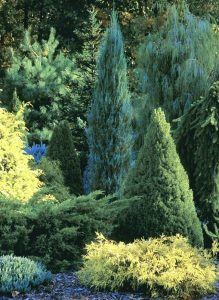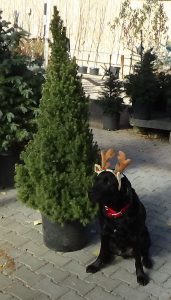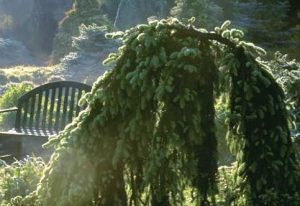By Ken Lain, the mountain gardener
Our house is a classic mountain home with large windows that enable us to enjoy both the natural and cultivated views. The landscape has been a labor of love, and the gardens finally are filling in and showing off their planned beauty. The design showcases each of the four seasons, but evergreens & conifers are the central focus. Their easy-care hardiness guarantees that they will look beautiful no matter the season. Even on the bleakest winter days the gardens are attractive thanks to the evergreens.
Prescott is famous for its rolling forests of pine and juniper, so it’s natural to begin a landscape plan with these conifers. Because evergreens and conifers come in all shapes and sizes they are useful for privacy screens, foundation plantings, backdrops for flowerbeds, and accents in rock gardens.
Mixing evergreen shapes and sizes can bring to life the part of the garden where  they are planted in combination. The screen pictured here blends the blues of skyrocket juniper with the green color of its cousin, the weeping juniper. The greens of the Alberta spruce and weeping Norway spruce contrast attractively with the golds of the Gold Coast juniper. The pleasing combination of colors and textures is there year ‘round, even in the middle of winter.
they are planted in combination. The screen pictured here blends the blues of skyrocket juniper with the green color of its cousin, the weeping juniper. The greens of the Alberta spruce and weeping Norway spruce contrast attractively with the golds of the Gold Coast juniper. The pleasing combination of colors and textures is there year ‘round, even in the middle of winter.
Choosing the best plant combinations can be tricky, and doing it well can be a challenge. Conifer colors are subtle, and their shapes never really change. A five-year-old conifer shaped like a Christmas tree will be the same cone shape when it is 50 years of age; only it will be larger.
Evergreens’ unchanging shapes are both charming and demanding to a gardener’s skills. The secret lies in combining their contrasting shapes and colors into a dynamic composition. Each tree or shrub is accentuated by its nearest neighbors, and the varied combinations yield varying results on the “canvas”, i.e. the garden.
It’s just a matter of mixing shapes and sizes. It just seems difficult when trying to grasp the concept from a printed column viewed on your iPad!
In my mind conifers come in four basic shapes: round, cylindrical, weeping, and flat ground huggers. For simplicity’s sake, I think of both a ball-shaped false cypress and a mound like ‘Blue Star’ juniper as being round. It’s helpful to think of them as silhouettes. Once you understand the shapes, making eye-catching combinations becomes easy and enjoyable.
When first landscaping with evergreens, begin with small groupings, and make sure each conifer is as different as possible from its neighbors. One of my favorite compositions begins with a ‘Bird Nest’ globe spruce. Place a broadly conical shaped hinoki cypress next to it. Maximize the contrast with an under planting of a flat, ground hugging Japanese juniper. Each enjoys growing together in tough mountain soil and on the same irrigation system as long as you don’t over water them. (More about that in a moment.)
Each evergreen conifer sold at Watters comes in a nursery container, even the really large specimens. Containers make them easy to arrange and rearrange in the garden before actually planting them. I often help clients arrange conifers right here in the nursery aisles. It all starts to click when the texture, shapes, and colors are put together.
You don’t want to plant a 12-inch high miniature next to something that will grow to a height of 50 feet; eventually the maxi will overpower the mini. In small planting beds, I use mainly miniatures and dwarfs, and I’ve discovered that intermediate-sized ground huggers like cotoneaster, juniper, and mahonia rarely overtake their allotted spaces. Slim cylinders like skyrocket juniper and tiny tower cypress serve well as accents and never get too massive.
When planting, leave plenty of room between each conifer. Generous spacing eliminates the need to move a crowded conifer after a few years. More space between plants also allows for better air circulation, thus promoting healthier growth. The real reason for generous spacing is aesthetics. The beauty of conifers’ shapes is diminished if their silhouettes are obscured by other plants.
A new garden that is properly spaced can look a bit sparse. This is where perennials can be a gardener’s best friends. Use perennials to fill the empty spaces and contribute extra color. Some of my favorites right now are day lilies, irises, and the ground hugging creeping thyme. There are many perennials that can be planted even as the nights grow cooler. Carnations, pinks, asters, and mums all bring nice contrasts to a conifer garden in autumn.
A few taller perennials that complement rather than compete with evergreens are the sedums, many of which are local evergreens. Local grasses serve well as partners to more substantial evergreens. Dwarf fountain grass, bunny grass, and deer grass are beautiful, hardy companions to the conifer garden.
Conifers are the kings of foliage plants, no matter the season. In early spring, the color of new candle growth appears exceptionally rich because so few flowers are up and blooming. In summer conifers provide a splashy backdrop for the most colorful bloomers. In fall, conifers take on a renewed glow. That’s when their greens, blues, and yellows contrast marvelously with autumn reds and yellows. But evergreens truly are in all their glory as we head into winter.
The mountains of Arizona are chilly, but even in the middle of winter the days are bright and warm, compared to other parts of the country. As conifers continue to root and form new candle buttons, they lose moisture through their needles. It is important to water established conifers with one deep soak per month.
It is not unusual, even preferable, to plant evergreens as we head into winter, but cold weather planting really makes watering critical. Water by hand if necessary, but don’t over do it. Newly planted conifers like a deep soak every 10-14 days.
Evergreen trees can be likened to the skyline of a city. Close-up views reveal the essence of an individual tree, or building, by baring its shape, color, and texture. But when seen from a distance, the colors and textures fade. Shapes dominate. Drama and a sense of wonder are experienced when blended together properly. Conifers are the structural backbone of a garden just as buildings are the architectural building blocks of a city.
If you feel a little down after the excitement of Thanksgiving, come visit Watters’  company mascot, Vincent Price. He roams freely through the garden center most days that Lisa and I work at the nursery. Vincent loves, loves, loves people and rarely passes up a good back rub, or doggy treat. We even had the wording on his service vest changed to read, “Service Dog, Please Pet Me”.
company mascot, Vincent Price. He roams freely through the garden center most days that Lisa and I work at the nursery. Vincent loves, loves, loves people and rarely passes up a good back rub, or doggy treat. We even had the wording on his service vest changed to read, “Service Dog, Please Pet Me”.
Ken Lain can be found throughout the week at Watters Garden Center, 1815 W. Iron Springs Rd in Prescott, or contacted through his web site at WattersGardenCenter.com or FB.com/WattersGardenCenter .


